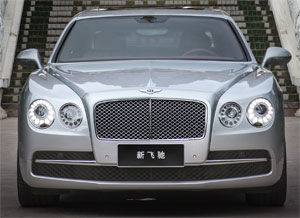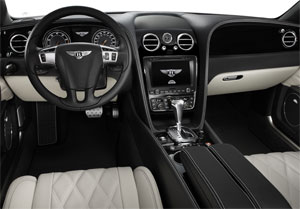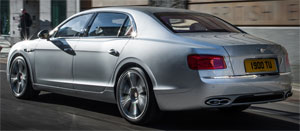2015 Bentley Flying Spur V8
Last year, the Bentley Flying Spur dropped Continental from its name, but it lost nothing when it came to showcasing British luxury performance motoring at its best. Well, this year it loses something else…4-cylinders from its signature W12 engine. So, let’s see if less turns out to be more.
Yes folks, as much as we hate to admit it, sometimes you can have too much of a good thing. That’s where this 2015 Bentley Flying Spur V8 comes in.
For some, 12-cylinders pumping in harmony to produce glorious amounts of power is just more than they can handle or perhaps wish to pay for.
But this is no lightweight V8 we’re talking about here. It’s Audi’s aluminum 4.0-liter twin-turbo unit that, after some unique Bentley tweaks, performs some internal combustion magic of its own, pulling 500-horsepower and 487 lb-ft. of torque. That may be over 100-horsepower less than the W12, but with 100-pounds of weight also removed from the front end, it should translate to a more enjoyable experience at the track.
So we “suited up” in proper Bentley fashion and made haste to our test facility. And unless you’ve recently driven the W12 Flying Spur, you’d be hard pressed to notice a difference in acceleration, as this thing just flat takes off. There’s gobs of power off the line, and rear-biased all-wheel-drive to apply it.
 Power continues to build in a very linear fashion, and 60 miles-per-hour arrives in just 4.6-seconds. That’s only a tenth off our time in the W12. The 8-speed automatic transmission provided smooth and fast shifts, and in 12.9-seconds, we were at the end of the ¼-mile with the needle pointing at 111 on the speedo. So, unless you absolutely will settle for nothing but the best or are always in a real hurry, there’s not much need for the 12.
Power continues to build in a very linear fashion, and 60 miles-per-hour arrives in just 4.6-seconds. That’s only a tenth off our time in the W12. The 8-speed automatic transmission provided smooth and fast shifts, and in 12.9-seconds, we were at the end of the ¼-mile with the needle pointing at 111 on the speedo. So, unless you absolutely will settle for nothing but the best or are always in a real hurry, there’s not much need for the 12.
At 5,300-pounds plus, there’s still a lot of weight to hustle through the cones. But this Flying Spur does so with surprising agility, though you want to make sure suspension is at its firmest setting to keep body roll at a minimum. You can find both under and over steer should you go looking, but initiating either requires some very aggressive inputs with the wheel or with the throttle.
Even more amazingly, bringing this 2½-ton dreamliner to a halt from 60 happens in just 107-feet, with smooth and steady stops that belie the frictional ferociousness that is transpiring behind this car’s 21-inch painted alloys.
Though technically no longer part of the Continental family, the Flying Spur sees similar exterior embellishments to last year’s Continental GT Coupe V8. That means it’ll take a keen or perhaps distinguished eye to spot the dark finish to the grilles, red background of the flying B logo, and figure-8 shaped exhaust finishers.
 There’s always lots to love when you’re talking about Bentley interiors. Now, we can’t say this Newmark tan motif would be our first choice in color as we prefer to leave the saddle-brown theme to our pickups, but material quality and finish are every bit as exquisite as you would expect.
There’s always lots to love when you’re talking about Bentley interiors. Now, we can’t say this Newmark tan motif would be our first choice in color as we prefer to leave the saddle-brown theme to our pickups, but material quality and finish are every bit as exquisite as you would expect.
Amenities include beautiful Eucalyptus wood veneer, picnic trays, Naim for Bentley Premium Audio, refrigerated bottle cooler, massaging seats, full length center console with seating for just two in the back, dual LCD screens, and a remote to control most of the cars functions from the back seat.
If you’re smart enough to send the chauffeur home for the day and take up residence in the front seat, you’ll agree that this may be the best handling close to 3-ton sedan out there. It does indeed feel massive, but highly capable and stable. Just plan ahead a bit for turns as there’s no dartiness to it.
While this basic chassis has been around for quite some time, and we wonder just how much further corporate parent Volkswagen can go with it, does the average luxury buyer really care about any of that? Probably not, and you won’t either. Just relax and enjoy the ride.
 Despite the smaller V8 engine, there’s still a gas guzzler tax, as Government Fuel Economy Ratings come in at 14-City, 24-Highway, and 17-Combined. Our average of 18.0 miles-per-gallon of Premium was around 8% better than we achieved in the W12 Flying Spur. That still makes for a very poor Energy Impact Score however, burning through 19.4-barrels of oil per year while expelling 8.5-tons of CO2.
Despite the smaller V8 engine, there’s still a gas guzzler tax, as Government Fuel Economy Ratings come in at 14-City, 24-Highway, and 17-Combined. Our average of 18.0 miles-per-gallon of Premium was around 8% better than we achieved in the W12 Flying Spur. That still makes for a very poor Energy Impact Score however, burning through 19.4-barrels of oil per year while expelling 8.5-tons of CO2.
Priced about $20,000 under the W12 at $200,245, it may be the everyman’s Flying Spur, but it’s still not for every man or woman; more for those with the necessary “funds” be they trust, hedge, or otherwise.
Much as in the Continental GT Coupe, the V8 engine in the 2015 Bentley Flying Spur sedan makes for a better overall car. Sure, in the luxury realm there is always an accepted space for prestigious overkill. But as far as we’re concerned, this is a case of less is more.
Specifications
- Engine: 4.0 liter
- Horsepower: 500
- Torque: 487 lb-ft.
- 0-60 mph: 4.6 seconds
- 1/4 mile: 12.9 seconds @ 111 mph
- EPA: 14 mpg city/ 24 mpg highway
- Energy Impact: 19.4 barrels of oil/yr
- CO2 Emissions: 8.5 tons/yr
2025 Volkswagen ID. Buzz
Volkswagen Brings Beetlemania Level Of Excitement To Minivan Segment
The duty of upholding Volkswagen’s heritage has most recently been delegated to small legacy car names like Golf and Jetta. But hold on! A much larger, totally modern take on VW’s classic microbus has just buzzed over the horizon— the all-electric ID. Buzz. It’s been at the top of our minds since we first saw the concept back in 2017. Well, it’s finally here, so let’s get our groove into drive!
This 2025 Volkswagen ID. Buzz has indeed created the most buzz around Volkswagen since the Beetle’s return to the U.S. in the late 1990s. We couldn’t drive it anywhere without drawing a crowd. No wonder, just about everyone has a VW Microbus story to tell, and seeing this reimagined version rolling down the street brings back all those memories.
VW really pulled it off as far as we’re concerned, as it looks great without appearing over the top. All the cues are here: Big VW logo front and center, lots of greenhouse including A-pillar windows and mini sliders for the second-row passengers, D-pillar air vents, and two-tone wheels. And while its appearance may be pure retro, its drivetrain is far from it, as the ID. Buzz is all-electric, and unlike the new Beetle, the Buzz does retain the original Microbus’ rear-drive architecture.
Powering those rear wheels is a 210-kW motor drawing juice from a 91-kWh battery for a range of 234 miles; 200-kW max charging will get you to 80% in about 26 minutes. Buyers can add another small 80-kW motor up front for 4motion all-wheel-drive and an increase of total output from 282 to 335 horsepower with a combined 512 lb-ft of torque. It uses the same battery, but range estimates drop just slightly to 231 miles. But while those numbers are modest, we also found them to be quite conservative, as we observed as many as 287 miles available in our all-wheel-drive tester’s gauge display and were on pace for 273 miles in our driving loop.
One throwback theme that may be a turnoff to some is that it’s quite a step up into the Buzz’s front seats, but there’s certainly a commanding view of the road once you climb in. Second row seating can be either a three-place bench or a pair of captain’s chairs, so there’s generous room for seven or six passengers. The captain’s chairs in our Pro S Plus offer good support and very easy access to the third row.
Lots of flexibility too with the option to simply fold the seats or remove them altogether.
With the sliding side doors and a wide opening rear hatch, there’s plenty of access for loading big sport utility amounts of cargo. Lots of flexibility too with the option to simply fold the seats or remove them altogether, and the ability to create a full-length flat floor with a rear cargo shelf that covers some handy removable storage bins. There’s 18.6 cubic-feet of space behind the third row, 75.5 behind the second, and a max of 145.5. That’s more than a Chevrolet Tahoe. For smaller items, there are lots of cubbies throughout the cabin, along with a standard Buzz Box that can be moved to multiple locations.
With a design that prioritizes retro form and modern function over aero efficiency, the 4motion equipped ID. Buzz earns a Fair efficiency rating, using 42-kWh of electricity per 100 miles, and we weren’t sure what to expect at our Mason Dixon test track.
What we found was great torque off the line and drama free launches to 60 in just 5.3 seconds. It was very stable at speed and power delivery stayed steady most of the way down the track until we reached about 90 mph, when it began to taper off just before we finished the quarter-mile in 14.0 seconds flat at 97 mph.
With 1,200-lbs. of battery weight nestled in its 127.5-inch wheelbase, the Buzz felt planted to the pavement through our handling course. There was quite a bit of body roll to deal with, but surprisingly little understeer. In panic braking runs, pedal response was inconsistent, feeling soft at times, pushing back hard at others; but through it all, results were quite good, stopping from 60 in an average of just 108 feet.
Three interior themes are available, this Dune is the brightest, featuring coastal inspired wood optic dash décor, “gray and clay” leatherette surfaces, and a high-mounted central 12.9-inch touchscreen. Pricing starts with a rear-wheel-drive Pro S at $61,545; this Pro S Plus begins at $65,045, add another $4,500 for 4motion, which brings a few extra features along with all-wheel drive.
Retro design with old-school VW charm, modern EV drivetrain, big SUV capacity merged with minivan flexibility; it all comes together in this 2025 Volkswagen ID. Buzz. It’s easily one of the coolest rides of the year and one that will likely keep Volkswagen dealers buzzing for years to come, and that’s something no other people and things mover can say.
Specifications
As Tested
- Motor Setup: Dual-Motor AWD
- Battery Size: 91-kWh
- Horsepower: 335
- Torque: 512 lb-ft
- EPA Range: 231 miles
- 0-60 mph: 5.3 seconds
- 1/4 Mile: 14.0 seconds at 97 mph
- Braking, 60-0: 108 feet
- MW Test Loop: ~ 273 miles













































